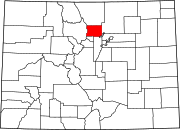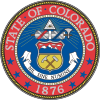Eldora, Colorado
Eldora, Colorado | |
|---|---|
 The Arcade Saloon in 1898 Eldora Colorado. | |
 Location in Boulder County and the state of Colorado | |
| Coordinates: 39°56′57″N 105°34′18″W / 39.94917°N 105.57167°WCoordinates: 39°56′57″N 105°34′18″W / 39.94917°N 105.57167°W | |
| Country | |
| State | |
| County | Boulder[1] |
| Area | |
| • Total | 4.2 sq mi (10.9 km2) |
| • Land | 4.2 sq mi (10.9 km2) |
| • Water | 0 sq mi (0 km2) |
| Elevation | 8,642 ft (2,634 m) |
| Population (2010) | |
| • Total | 142 |
| • Density | 40.5/sq mi (15.6/km2) |
| Time zone | UTC-7 (MST) |
| • Summer (DST) | UTC-6 (MDT) |
| FIPS code | 08-23575 |
| GNIS feature ID | 0181070 |
Eldora (pronounced el-DOH-ruh),[2] previously known as "Eldorado" then "El-Dora", then Eldora or Camp Eldorado, and still called Happy Valley,[3][4][5] is an unincorporated community and a census-designated place (CDP) located in Boulder County, Colorado. The population was 142 at the 2010 census.[6] The CDP of Eldora is more commonly referred to as a small town or village.[7][8][9][10]
Eldora is located within the Roosevelt National Forest, and is primarily a rural, densely forested, and sparsely populated area. Eldora is tucked into the valley carved by glaciation during the last ice age and by Middle Boulder Creek. From the village there are views up toward the alpine ski runs of Eldora Mountain Resort.[11] A one-time gold camp, Eldora was a shipping point for the Caribou silver mine in nearby Nederland, CO.[12] At present, Eldora is characterized by small cabins, a sprinkling of vacation homes, and several long-shuttered mercantiles.
Points of interest near Eldora include the Eldora Mountain Resort, Eldora Historic District, and Indian Peaks Wilderness.[4] Eldora Historic District has been listed on the U.S. National Register of Historic Places since 1989.[13] The area is home to an abundance of wilderness and wildlife, including animals such as mountain lions, black bears, coyotes, red foxes, mule deer, elk, bobcats, and much more.[14]
The elevation of the town is 8,700 ft.,[12] and the highest point is 10,800 ft.[15] Eldora receives a heavy annual snowfall of 300 inches each winter.[16]
To get to Eldora from Boulder, CO, drive 18 miles west of Boulder on CO 119 to Nederland, CO. Continue through Nederland and turn right at the sign for Eldora. This road is CR 130, also known as Eldora Road. The town center of Eldora is approximately 3 miles from this turn.[17]
Etymology[edit]
Eldora was originally named Happy Valley in the 1890s for the discovery of the Happy Valley Placer Mine by John J. Kemp and seven city associates.[4] The town was soon renamed El Dorado,[18] Eldorado or Eldorado Camp. But, as frequently happened at the time, the U.S. Postal Service mistakingly delivered their mail to towns by the same name in other U.S. states, particularly to El Dorado, CA,[18][19] creating havoc by delaying payroll checks and important papers. Consequently, the U.S. Post Service changed the conflicting name by dropping the last syllable "do" from Colorado's Eldorado.[4] That name change occurred in 1898, one year after the local post office was established (Feb. 13, 1897), which was in use until it closed in September 1977.[3]
History[edit]

Eldora was first settled by the Arapaho- and Ute people who used the area for hunting during summer.[20] Eldora was originally built as a mining town.[21] Although prospectors had been poking around in Eldora since the early 1850s, it was not until 1875 that enough gold was discovered to open a mine in Eldora.[22] The primary decision to officially establish a town in the 1880s was in part an effort to open up further mining area, and in part an attempt at a through route into Middle Park and Western Colorado.[23] Eldora boomed and prospered during the 1890s, and at one point, Eldora was home to as many as 1300-1500 people in the late 1890s. In 1898, Eldora was home to a bank, a post office, a school, nine hair saloons and seven grocery stores.[4][20] Although it had a mining life of its own, Eldora also served as a supply center for the camps beyond, and a rail-road shipping center for the camps in the nearby area. The first time the manager of the Bailey Chlorination Mill in Eldora, Mr. Bailey, neglected to pay his workers on time, angry employees promptly gathered at his house, smoked him out, and shot and killed Mr. Bailey.[4][18][24] Despite its intensity of gold, silver and tungsten mining, Eldora's economic boom was brief. It peaked at the turn of the century, but experienced a devastating wildfire in 1899. With much of its timber lost, lumber that was vital to the mining construction was in short supply. The 21st century has experienced renewed interest in Eldora mining, with hopes of reopening the Mogul Tunnel Mine on Spencer Mountain.[25]
Geography[edit]
Eldora is a small village located in the southwestern parts of Boulder County, Colorado. It is located at 39°56′57″N 105°34′18″W / 39.94917°N 105.57167°W (39.949111, -105.571644).[26] According to the United States Census Bureau, the CDP has a total area of 4.2 square miles (11 km2), all of it land. Eldora is located within the Roosevelt National Forest, at the base of Ute Mountains in the Middle Boulder Creek valley. It is situated immediately above the Colorado banana belt. The nearest town is Nederland, Colorado, four miles east of Eldora.[18] From Boulder, CO, you follow Colorado 119 through Boulder Canyon to Nederland, CO, and then head south-west into Eldora.[4] Eldora is a rural, densely forested, and sparsely populated community.
Demographics[edit]
| Historical population | |||
|---|---|---|---|
| Census | Pop. | %± | |
| U.S. Decennial Census[27] | |||
As of the census[28] of 2000, there were 170 people, 89 households, and 42 families residing in the CDP. The population density was 40.5 people per square mile (15.6/km2). There were 245 housing units at an average density of 58.3 per square mile (22.5/km2). The racial makeup of the CDP was 98.24% White, and 1.76% from two or more races. Hispanic or Latino of any race were 5.88% of the population.
There were 89 households, out of which 20.2% had children under the age of 18 living with them, 43.8% were married couples living together, 3.4% had a female householder with no husband present, and 51.7% were non-families. 42.7% of all households were made up of individuals, and 3.4% had someone living alone who was 65 years of age or older. The average household size was 1.91 and the average family size was 2.67.
In the CDP, the population was spread out, with 15.3% under the age of 18, 2.4% from 18 to 24, 50.6% from 25 to 44, 23.5% from 45 to 64, and 8.2% who were 65 years of age or older. The median age was 38 years. For every 100 females, there were 142.9 males. For every 100 females age 18 and over, there were 128.6 males.
The median income for a household in the CDP was $51,875, and the median income for a family was $55,625. Males had a median income of $41,563 versus $29,583 for females. The per capita income for the CDP was $22,191. None of the families and 8.6% of the population were living below the poverty line.
See also[edit]
References[edit]
- ^ a b "US Board on Geographic Names". United States Geological Survey. 2007-10-25. Retrieved 2008-01-31.
- ^ Benson, Maxine (1994). 1001 Colorado Place Names. University Press of Kansas. Page 64. ISBN 9780700606320.
- ^ a b http://www.rootsweb.ancestry.com/~bgs/project_items/Colorado_Place_Names_for_1890_Census_Reconstruction.pdf
- ^ a b c d e f g Bauer, Carolyn (1987). Colorado Ghost Towns: Remnants of Colorado's Mining Days. American Traveler Press. Page 19. ISBN 9781558380677.
- ^ Langley, John R. and Donald Campbell Kemp (1945). Happy Valley, a Promoter's Paradise: Being an Historic Sketch of Eldora, Colorado and Its Environs. Smith-Brooks Printing Company.
- ^ Colorado Trend Report 2: State and Complete Places (Sub-state 2010 Census Data). Archived 2012-07-11 at Archive.today Missouri Census Data Center. Accessed 2011-02-25.
- ^ Roach, Gerry (1998). Colorado's Indian Peaks: Classic Hikes and Climbs. Fulcrum Publishing. Page 5. ISBN 9781555914042.
- ^ Muller, Dave (2003). The Colorado Year Round Outdoor Guide. The Mountaineers Books. Page 44 and page 194. ISBN 9780972441322
- ^ Grinstead, Steve and Ben Fogelberg (2006). Walking Into Colorado's Past: 50 Front Range History Hikes. Big Earth Publishing. Page 78. ISBN 9781565795198.
- ^ Dziezynski, James (2012). Best Summit Hikes in Colorado: An Opinionated Guide to 50+ Ascents of Classic and Little-Known Peaks from 8,144 to 14,433 feet. Wilderness Press. Page 68. ISBN 9780899977126.
- ^ Walter, Claire (2004). Snowshoeing Colorado. Fulcrum Publishing. Page 92. ISBN 9781555915292.
- ^ a b Writers' Program of the Work Projects Administration in the State of Colorado (1948). Colorado, a Guide to the Highest State. North American Book Dist LLC. Page 268. ISBN 9780403021581.
- ^ "Archived copy". Archived from the original on 2010-12-04. Retrieved 2015-03-03.CS1 maint: archived copy as title (link)
- ^ http://www.stateparks.com/eldorado_canyon_state_park_in_colorado.html
- ^ Forster, Matt (2011). Explorer's Guide Colorado. The Countryman Press. Page 75. ISBN 9780881509564
- ^ Forster, Matt (2011). Explorer's Guide Colorado. The Countryman Press. Page 76. ISBN 9780881509564.
- ^ Grinstead, Steve and Ben Fogelberg (2006). Walking Into Colorado's Past: 50 Front Range History Hikes. Big Earth Publishing. Page 74. ISBN 9781565795198.
- ^ a b c d Dallas, Sandra (1988). Colorado Ghost Towns and Mining Camps. University of Oklahoma Press. Page 71. ISBN 9780806120843.
- ^ Crossen, Forest (1962). The Switzerland Trail of America: An Illustrated History of the Romantic Narrow Gauge Lines Running West from Boulder, Colorado: the Greeley, Salt Lake & Pacific, and the Colorado & Northwestern, Later the Denver, Boulder & Western. Pruett Press. Page 335.
- ^ a b In the magazine Ski Vol. 65, No. 6 (Feb. 2001). Page 62. ISSN 0037-6159.
- ^ Kindig, Jean Matthews (2010). Eldora!: The Transition of a Mining Community in the Colorado Rockies. Sine nomine.
- ^ Hlawaty, Stephen (2014). Mountain Biking Colorado's Front Range: From Fort Collins To Colorado Springs. Rowman & Littlefield. Page 138. ISBN 9781493014170.
- ^ Hilton, George Woodman (1990). American Narrow Gauge Railroads. Stanford University Press. Page 340. ISBN 9780804717311.
- ^ Eberhart, Perry (1981). Guide to the Colorado ghost towns and mining camps. Swallow Press. Page 72. ISBN 9780804001403.
- ^ Hlawaty, Stephen (2014). Mountain Biking Colorado's Front Range: From Fort Collins To Colorado Springs. Rowman & Littlefield. Pages 139-140. ISBN 9781493014170.
- ^ "US Gazetteer files: 2010, 2000, and 1990". United States Census Bureau. 2011-02-12. Retrieved 2011-04-23.
- ^ "Census of Population and Housing". Census.gov. Retrieved June 4, 2016.
- ^ "U.S. Census website". United States Census Bureau. Retrieved 2008-01-31.





No comments:
Post a Comment